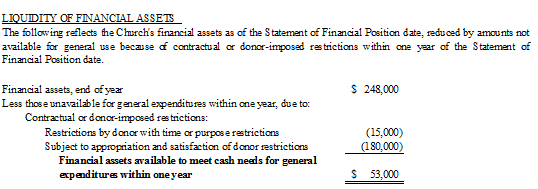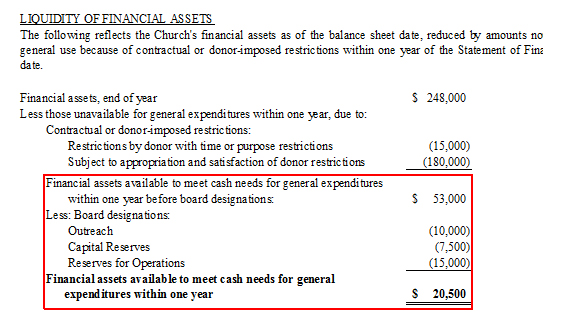Nonprofit Resources
Qualitative Liquidity & Availability Disclosure Considerations for Churches in ASU 2016-14
Among the many nonprofit financial reporting standards changes in Financial Accounting Standards Board (FASB) Accounting Standards Update (ASU) 2016-14, one of particular importance to churches is the new liquidity and availability disclosure. The ASU is the biggest change to nonprofit financial reporting in 25 years, and it is intended to improve information in nonprofit financial statements and notes about financial performance, cash flows, liquidity, and availability.
All churches that issue external financial statements (complete with footnote disclosures) for fiscal years beginning after December 15, 2017 (calendar year 2018 and fiscal years ending in 2019) are subject to the new nonprofit financial reporting requirements. However, as a best practice, even churches that don’t issue external financial statements should have a written cash management policy that could have content and attributes similar to these new qualitative disclosure requirements.
This article focuses on the additional qualitative or non-numerical disclosures required by ASU 2016-14. See this previous article for information about the quantitative or numerical aspects of this disclosure.
Qualitative Disclosure Requirements
The ASU requires disclosure of essential qualitative information about the availability of your church’s financial assets at the Statement of Financial Position date to meet cash needs for general expenditures within one year of that date. This disclosure typically follows the quantitative or numerical sum total of available assets and adds additional written factors that explain how your church manages its liquid resources. The information for the disclosure usually comes from the church’s cash management policies and practices.
Best Practices for Cash and Liquidity Management
Here are some strategies and best practices I have seen churches use to manage their cash flows and liquidity effectively:
- Set up a balanced budget every year. This budget should be realistic and include required debt service obligations, even if the debt service is funded by restricted gifts.
- Develop a policy that requires the budget to be approved before the start of the new fiscal year.
- If your church’s operating reserves are not funded adequately, set up an operating line of credit as a way to address your church’s cash management policy. This is especially useful for churches impacted by this new ASU.
- Accumulate funded operating cash reserves to cover a minimum number of days of cash operating expenses. (This is the “Days Operating Cash and Investments on Hand to Fund Annual Cash Expenditures” measure in the CapinCrouse Comprehensive Church Financial Health Index™)
- Accumulate funded cash reserves for anticipated upcoming expenditures for fixed asset purchases (capital), major repair and maintenance (roof, parking lot, HVAC), and other future ministry programs or projects included in the church’s five-year strategic plan.
- If cash flows allow, develop a strategy to pay off existing debt ahead of schedule.
- Long-term goals should include establishing endowment funds.
- Establish a practice of having any board-designated funds formally approved in the church minutes when they are established. For example, any board-designated funds disclosed in the 2017 external financial statements and any new funds established in 2018 would need to be formally approved in the church minutes when established. If any existing board-designated funds have not been formally approved, we recommend this be done before the end of the fiscal year.
These policies and practices form the basis for the qualitative disclosures below.
Disclosure Examples
Figure 1 shows a sample quantitative disclosure for a church that does not have board-designated funds:
Figure 1

Here is a sample qualitative paragraph that may accompany this chart:
In the example above, the church does not have board-designated reserves. In a previous article in this series, we discussed the impact of board-designated reserves on this total and the fact that the ending total is reduced by these board designations. We recommended adding a subtotal before the board designations, as shown in Figure 2:
Figure 2

The qualitative paragraph could then refer to the subtotal line to make it easier for the reader to understand your church’s financial position, as follows:
The Church is substantially supported by unrestricted and restricted contributions. Because a donor’s restriction requires resources to be used in a particular manner or in a future period, the church must maintain sufficient resources to meet those responsibilities to its donors. Thus, financial assets may not be available for general expenditure within one year. As part of the church’s liquidity management, it has a policy to structure its financial assets to be available as its general expenditures, liabilities, and other obligations come due. Another part of this policy is the congregation’s approval of the annual balanced budget in [Month] [Year]. In addition, the church invests cash in excess of daily requirements in short-term investments.
Occasionally, the board designates a portion of any operating surplus to its operating reserves, which totaled $15,000 as of December 31, 201X. The sub-total “Financial assets available to meet cash needs for general expenditures within one year before board designations” represents another liquidity total, as board-designated reserves can be reversed and made available for immediate use in the event of an urgent liquidity need. The church could also draw upon a $50,000 available operating line of credit (as further discussed in Note XX).
Operating Lines of Credit as Additional Liquidity Sources
Some churches carry operating lines of credit as additional sources of liquidity even if the church does not have the intention to draw from the line. These extra liquidity sources would be explained in the qualitative section of the disclosure as follows:
Or:
It’s important to note that your church should not use the new disclosure amount to measure operating reserves. One tool that can be very useful to management and the board in monitoring these reserves is the CapinCrouse Church Financial Health Index, an online dashboard with key measures, ratios, benchmarks, and peer information that answer the following questions:
- Are we using our financial resources as efficiently as possible?
- How does our church compare with similar churches?
- What financial indicators should we monitor, and how?
- Are we financially healthy?
I use the ratios in this tool with many churches and their boards to monitor cash reserve and liquidity levels.
If your church hasn’t thought about how the liquidity disclosures will look in the footnotes, now is the time so you can consider these factors before the end of your fiscal year. This is especially important for churches with a December 31, 2018, fiscal year-end.
This article appears on XPastor.org.
Additional Resources:
Liquidity & Availability Disclosure Considerations for Churches in ASU 2016-14

Richard Lindley
Richard is an Audit* Manager at CapinCrouse and has managed audit, review*, and compilation engagements for more than 25 years. He is a former member of the firm’s Church and Denominational Team, and helped draft the CapinCrouse Church Financial Health Index™ and CapinCrouse Church Assessment and related reports. Richard also provides additional services in a variety of areas, including local church consulting reviews, organizational governance, audit committee roles and responsibilities, and internal control. Richard also serves as his church’s finance ministry leader and is a former member of the executive building committee.